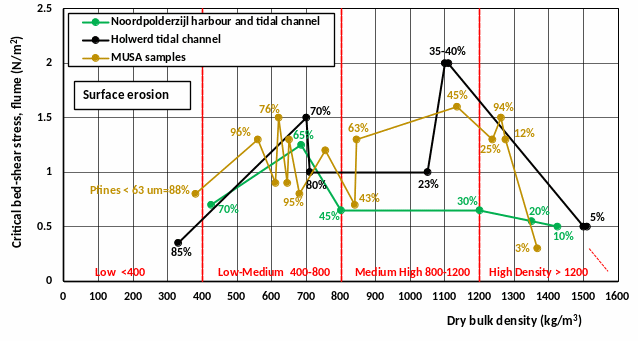M. Boechat Albernaz1*, L. van Rijn2, D. Schoonhoven1, L. Perk1, B. van Maren3, Y. Huismans3
1 WaterProof BV
2 Leo van Rijn Consultancy
3 Deltares
*corresponding author:
Much is known about the rheological behavior of the individual muddy and sandy sediments. However, the interaction between mud and sand in determining erosion and deposition processes remains limited. Consequently, the available formulations to predict sediment transport and bed evolution in mud-sand environments, such as estuaries and tidal basin, remains rather uncertain and inaccurate. In the MUSA-research project, we aim to increase our understanding on the combined effects of mud and sand by means of fieldwork campaigns and physical experiments. For this 124 sediment samples were collected from the tidal harbor of Noordpolderzijl (Wadden Sea) and from the intertidal flats of the Western Scheldt estuary, both sites located in the Netherlands. Based on the mud-sand percentages and dry bulk density 15 samples were selected, for which flow-flume experiments were performed to determine the critical shear stress for erosion over a wide range of mud-sand combinations. The samples covered a wide range of sand percentages between 2 and 90% and dry bulk densities between 400 and 1300 kg/m³. In total 18 flow-flume experiments were performed varying 3 to 4 dilutions per sample, in addition to the original sample. The critical shear stress necessary to erode increased up to 1.5-2 N/m² for intermediate percentages of mud-sand and medium to high bulk densities. This increase was particularly observed for mud-samples with higher percentages of clay over silt, due to the cohesive properties of clay. For the lower bulk densities, e.g. <400 kg/m³, and higher sand contents (low cohesion properties) no clear correlation was observed between the critical shear stress and composition or density. Values were in the range of 0.3-1.0 N/m² converging to analogue Shields mobility value. In conclusion, we found that intermediate percentages of mud-sand combined with medium to high dry bulk densities (800-1200 kg/m³) require higher shear stress to initiate erosion in comparison with pure mud and pure sand. These finding are in agreement with the theoretical background and previous research based on the fact that the cohesive properties of mud, especially clay, and higher bulk densities require more energy to be eroded in comparison with sandy and low-density sediments (van Ledden, 2003). However, here we show that intermediate percentage sand-mud mixtures require higher energy to start erosion in comparison with the mud and sand rich end-members.
This research is the initial phase of the MUSA-project. In the future we will expand the scope with current-waves experiments, field work and more comprehensive analysis before incorporating the finding on sediment transport formulations and numerical models.

Figure 1: Critical bed-shear stress for surface erosion as function of dry density and percentage of fines.
References:
Van Ledden, M. (2003). Sand-mud segregation in estuaries and tidal basins. PhD thesis; TU Delft
I. Surname1*, F.N. Another-Surname2 , Y. Next-Surname2
1 University Name, Country; 2 Organization Name, Country
* Corresponding author: mail.name@organization.org


